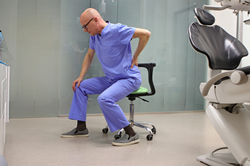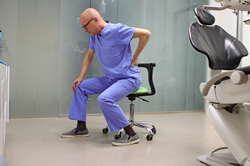
Ergonomic design is not a luxury; in the dental profession, it can prevent a career-ending injury
CLEARWATER, Fla. (PRWEB)
April 18, 2023
OSHA states that work-related musculoskeletal disorders (MSDs) are one of the most common reasons for missing work, the instances of which can be mitigated through the implementation of basic ergonomic principles in the workplace.(1) According to the CDC, work-related MSDs are injuries of the muscles, nerves, joints, or spinal discs sustained at work and exacerbated by the performance of one’s job.(2) MSDs are a pervasive affliction among dental health professionals affecting 64% to 93% of dentists and dental hygienists primarily due to prolonged static postures and repetitive movements.(3) Adrian LaTrace, CEO of Boyd Industries, observes, “A good dental provider does everything they can to relax their patients during any dental procedure, frequently at the expense of their own physical well-being. Dentists and hygienists assume awkward postures while performing repetitive tasks, positioning themselves rigidly in an effort to maintain precise movements so as to minimize patient discomfort. Ergonomic design is not a luxury; in the dental profession, it can prevent a career-ending injury.”
The World Health Organization affirms that musculoskeletal infirmities are the most reported disabilities worldwide, with lower back pain as the primary cause of disability in 160 countries.(4) Chronic musculoskeletal pain can lead to poor mental health leading to symptoms including anxiety, fatigue, depression, and insomnia. (5) MSDs in the dental profession have been shown to develop as early as dental school and are a harbinger of early retirement.(6) OSHA offers the “10 Principles of Ergonomics” training guidelines for the workplace, encouraging proactive remedies, such as maintaining neutral postures, reducing excessive force and motions, and working at the proper height; great advice, but impractical within the demands of the dental profession. (7) A lift-with-the-knees mentality fails to address the totality of the cause-and-effect predicament where conventional wisdom fails to resolve the problem.
Workplace ergonomics in the dental industry needs to be ubiquitous, from the front desk to the treatment chair and surrounding dental operatory equipment. It needs to be a holistic strategy that appreciates and anticipates every environmental factor that impedes efficiency and wellness. Boyd Industries, long known as the market leader in the design and manufacture of highly-reliable, innovative dental and medical operatory equipment, is renowned for its fine craftsmanship, ergonomic design, superior durability, and proven reliability. Boyd’s award-winning products include a full line of dental exam, treatment, and surgery chairs, delivery systems, exam lighting, custom clinical cabinetry, operator seating, and other office accessories.
Constantly hunching over patients can lead to musculoskeletal injuries of the neck and back. Boyd’s doctor and assistant seating comes in two height ranges with adjustable lumbar support to promote good posture. Dental treatment chairs with vertical lift adjustment in combination with dental operator chairs match optimal positioning for doctor comfort with one-touch memory settings for common patient positioning. Boyd’s mobile cabinetry, carts, and side units eliminate the fatigue of constantly reaching for equipment. Inadequate lighting causes eye strain and, over time, can lead to more serious vision issues. Boyd’s examination lighting moves freely and fully illuminates the oral cavity using natural white light, which has been proven to reduce eye fatigue.
LaTrace explains, “The benefits of an ergonomic office depend upon the individual needs of each member of the entire team; what might work for one might not work for another. Boyd provides customizable solutions to address the unique requirements of dental staff and patients.” With over 65 years of design and manufacturing expertise, Boyd creates the personalized products and equipment that dental specialists need. Made in the U.S.A., Boyd’s equipment is the #1 choice of Orthodontists, Oral Surgeons, Pediatric Dentists, Endodontists, and other dental professionals worldwide.
Built to last. Built for you. Built by Boyd.
About Boyd Industries
For 65 years, Boyd Industries has been the innovative market leader in the design and manufacture of dental and medical operatory equipment. Their high-quality and reliable equipment has been the choice of dental specialty practices and dental surgery offices. The rapidly expanding Ear, Nose, and Throat market now seeks its reputation for quality and innovation. Boyd equipment is specifically designed to provide maximum practice productivity while incorporating ergonomic characteristics for the doctor, staff, and patient. As an original equipment manufacturer, they use a vertically integrated approach to ensure their process meets high-quality standards. This approach allows Boyd to control each step of component fabrication and product assembly. Boyd’s products include a full line of dental exam, treatment, and surgical chairs, dental delivery systems, LED exam and surgical lighting, custom sterilization and storage cabinetry, and doctor or assistant seating. Boyd was named the Senate Small Business of the Week in November 2020 and is a ten-time winner of the Townie Choice Award for excellence in orthodontic operatory equipment. Boyd Industries is an FDA-registered manufacturer. Built to last. Built for you. Built by Boyd. http://www.boydindustries.com/.
References:
1. Department of Labor Logo United Statesdepartment of Labor. Ergonomics – Overview | Occupational Safety and Health Administration. (n.d.). Retrieved March 21, 2023, from osha.gov/ergonomics
2. Centers for Disease Control and Prevention. (2020, February 12). Work-related Musculoskeletal Disorders; Ergonomics. Centers for Disease Control and Prevention. Retrieved March 21, 2023, from cdc.gov/workplacehealthpromotion/health-strategies/musculoskeletal-disorders/index.html
3. Ludwig, E. A. (2022, September 23). Ergonomic equipment considerations for the dental hygienist – dimensions of Dental Hygiene: Magazine. Dimensions of Dental Hygiene | Magazine. Retrieved March 21, 2023, from dimensionsofdentalhygiene.com/article/ergonomic-equipment-considerations-for-the-dental-hygienist/
4. World Health Organization. (n.d.). Musculoskeletal health. World Health Organization. Retrieved March 21, 2023, from who.int/news-room/fact-sheets/detail/musculoskeletal-conditions#:~:text=Approximately%201.71%20billion%20people%20have,of%20disability%20in%20160%20countries
5. Garnæs, K. K., Mørkved, S., Tønne, T., Furan, L., Vasseljen, O.; Johannessen, H. H. (2022, December 22). Mental health among patients with chronic musculoskeletal pain and its relation to number of pain sites and pain intensity, a cross-sectional study among primary health care patients – BMC musculoskeletal disorders. BioMed Central. Retrieved March 21, 2023, from bmcmusculoskeletdisord.biomedcentral.com/articles/10.1186/s12891-022-06051-9
6. NN, L. (n.d.). Work-related musculoskeletal disorders in dental students: A cross-sectional, pilot study from a UK University Teaching Hospital. Work-Related Musculoskeletal Disorders in Dental Students: A Cross-Sectional, Pilot Study from a UK University Teaching Hospital. Retrieved March 21, 2023, from clinmedjournals.org/articles/jmdt/journal-of-musculoskeletal-disorders-and-treatment-jmdt-6-079.php
7. Home | occupational safety and health administration. (n.d.). Retrieved March 22, 2023, from osha.gov/sites/default/files/2018-11/fy12_sh-23543-12_ErgoforTrainers-TTTProgram.pdf
Share article on social media or email:

